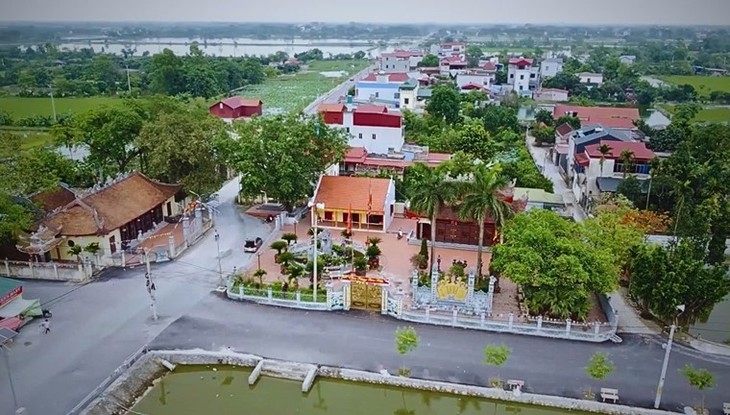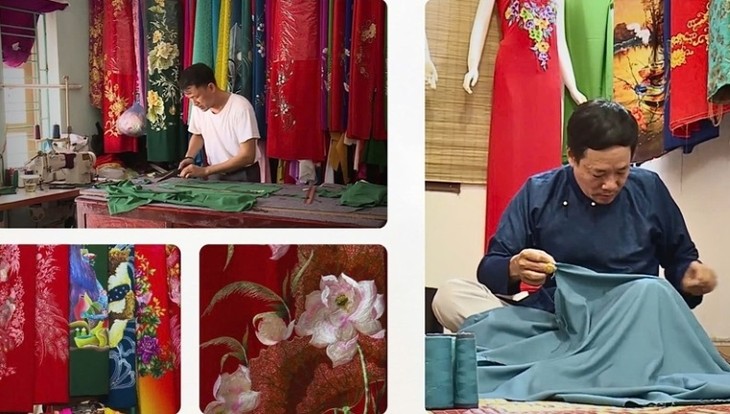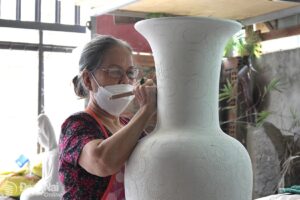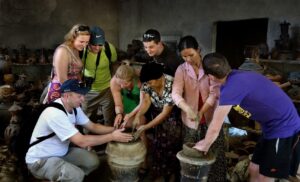Trach Xa village, 60 kilometers from Ha Noi, is famous for its tailor-made áo dài, Vietnam’s traditional long dress. The village and its craft are more than 1,000 years old. Techniques and secrets passed down from generation to generation make the Trach Xa brand, which has been honored as a National Intangible Cultural Heritage.

Trach Xa communal house worships the craft’s progenitor. (Photo: Nha Uyen/qdnd.vn)
Trach Xa village has been called the cradle of ao dai. It is a special village where the men sew and the women do farm work. The male villagers have been designing, cutting, and sewing for 1,000 years. Recently Trach Xa’s women have started learning the craft, too.
Local tailor Vu Thi Hang said, “In the past, when there were no machines, the Trach Xa men used their measuring tape, needle, thread, and scissors and went all over the country to do business. In the modern era, villagers have been passing down the profession to daughters and daughters-in-law as well as to sons and sons-in-law.”
Trach Xa village has 500 households and most of them make a living by sewing ao dai. Children as young as six or seven are introduced to the trade and are proficient in sewing by the time they reach 15 or 16. Some families have three or four generations making ao dai together. The village has many tailors who have been recognized as master artisans.
One of them, named Nghiem Van Dat, told us that this profession has been passed down from father to son since ancient times.
“I’ve been doing it since I was little. First we were taught how to hold a needle and then we learned to sew. It takes time to learn this craft, but thanks to heredity, perhaps we learn a bit more quickly than others,” said Dat.
He went on to say, “Trach Xa tailors can make both traditional and modern style ao dai. The local women are skilled, but they can't do it as beautifully as the men, who have their secrets for making ao dai which, when completed, are very beautiful. My children follow this craft. If a villager doesn't know how, we teach them, so they can help us preserve the identity of the village.”
What makes Trach Xa village special is its vertical hand-stitching technique. Most other places sew horizontally. This technique hides the stitches and thread inside the dress flaps.
Do Minh Tam, a master tailor with 40 years of experience, said, “On one hem of the dress flap, we use up to seven stitches - one machine stitch, three sewing stitches, and three basting stitches.”
“To do traditional sewing, a Trach Xa tailor must learn a saying which means the inside edge appears seamless, with no visible stitches, while the outside edge has straight, even stitches. We consider this our trade secret, the key, and everyone must strictly follow it,” Tam noted.

In Trach Xa village, men sew and the women do farm work. (Photo: Nha Uyen/qdnd.vn)
Making a beautiful ao dai requires the tailor to complete steps that only those in the craft can perform correctly. Each ao dai is made to individual measurements using even stitches, and the flaps must be soft and graceful.
It costs 14 USD to sew one ao dai panel in addition to the cost of the material and any attached decoration. An ao dai with attached gemstones and hand embroidery can cost anywhere from 800 to 8,000 USD.
The busiest time for Trach Xa village is October and November, when the demand for Tet ao dai increases. As the craft has developed, so has Trach Xa village. It now has clean paved roads and spacious houses, and people's lives are more prosperous. Many villagers have their own shop.
Trach Xa ao dai are often introduced at events to promote Ha Noi culture and tourism, giving tailors an opportunity to expand their business. Their ao dai have been exported to China, South Korea, and Mongolia.
Last year, Trach Xa was officially recognized as a traditional ao dai village by the Ministry of Culture, Sports and Tourism. At the end of December, the village craft was recognized as a national intangible cultural heritage. This recognition brought honor, pride, and encouragement to the villagers of Trach Xa.














